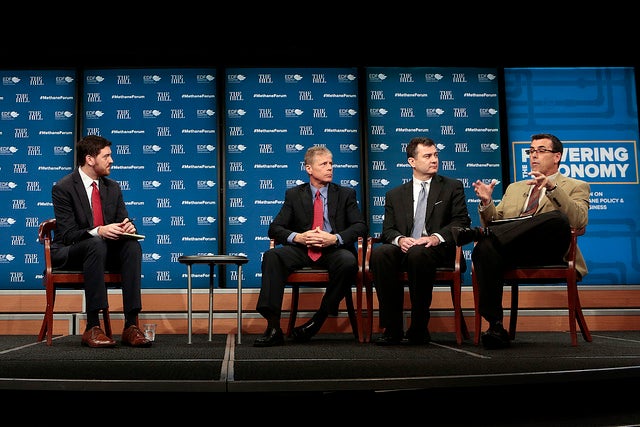 There is often staunch disagreement between industry and policymakers on how to address pollution. But an event last week convening business leaders, federal and state officials and other stakeholders showed that there’s at least one idea on which they can agree and work together: the feasibility of reducing methane emissions from the oil and gas sector.
There is often staunch disagreement between industry and policymakers on how to address pollution. But an event last week convening business leaders, federal and state officials and other stakeholders showed that there’s at least one idea on which they can agree and work together: the feasibility of reducing methane emissions from the oil and gas sector.
Here are four perspectives shared at this event that give me hope we can solve the large, but addressable problem of methane pollution from the oil and gas industry if we take a fact-based, collaborative approach. That would be great news in itself, and powerful precedent for tackling the broader climate opportunities ahead.
Environmental regulations are not a zero sum game. Martha Rudolph, director of Environmental Programs at the Colorado Department of Public Health and Environment, was on the front lines when Colorado proposed the nation’s first direct regulation of methane pollution from the oil and gas industry. At the event, she shared her state’s powerful example of unlikely allies coming together to protect climate and communities in a way that makes business sense.
Instead of tales of industry resistance, she shared a history of business and other stakeholders coming together with state policy makers to formulate and implement cost-effective regulations that will cut 100,000 tons of methane emissions – the climate equivalent of taking over 1.8 million cars off the road. Rudolph reports that the rules have not been challenged in court, and to date, her office had not heard complaints about compliance being difficult or costly . Noble, Anadarko, and Encana supported strong rules at the front end, and even the industry trade associations have rolled up their sleeves and set up trainings to ease rule implementation.
Federal regulators are constantly listening to and learning from industry and community concerns. At Tuesday’s event, Joe Goffman, EPA’s associate assistant administrator, gave us a window into EPA’s outreach to industry and communities ahead of and during the methane and other rule makings. He shared how smart regulations that set a basic floor, combined with industry action to push the ceiling ever higher, can be complementary, saying, “it’s the role of the EPA…. to formulate the rules of the game. But it’s really up tothe stakeholder community, and above all the business community, to find the strategies, the initiatives, and ultimately the innovations to make the outcome we’re going for.”
 Rather than assuming they know best, Goffman and former EPA Assistant Administrator Bob Perciasepe shared the appreciation EPA officials have for the comment period underway right now, with Perciasepe even calling this time of stakeholder engagement the “golden moment of a regulatory process.”
Rather than assuming they know best, Goffman and former EPA Assistant Administrator Bob Perciasepe shared the appreciation EPA officials have for the comment period underway right now, with Perciasepe even calling this time of stakeholder engagement the “golden moment of a regulatory process.”
Leading companies recognize the need to raise the bar. Companies sometimes fight against regulations, or sit tight and do the bare minimum required for compliance. However, Southwestern Energy’s officer Mark Boling advocated for aggressive industry action to cut methane emissions from today’s infrastructure, and left no doubt that we can get going with proven, cost effective technologies.
Boling affirmed that with industry leadership, the White House’s 40 to 45 percent oil and gas methane reduction goal is possible, and praised programs such as DOE’s MONITOR program that work to unleash the power of technological innovation to create real-time methane detection to cut emissions even further. And he echoed the value of industry working collaboratively with government, praising EPA as “very good at listening to [our] concerns and also very good at looking at what the science is telling us.”
Investment decisions in energy policy are not black and white. Rather than calling for fossil fuel divestment or defending the status quo of under-regulation, Brian Rice explained that his organization, CalSTRS, has a responsibility as an investor representing California teachers to “encourage companies to be more attentive to environmental issues” and specifically, “do what we can to get companies to reduce emissions.” CalSTRS is asking oil and gas companies to clean up their operations, which includes constructively engaging with EPA’s methane rulemaking process, as well as adopting best practices.
In addition to preventing climate risk and improving corporate reputation, investors want companies to address methane pollution because there’s an economic argument for encouraging them to get more product –natural gas, which is mostly methane – to the end user to increase revenues.
There are many private and public sector leaders out there who share the perspectives and constructive approaches of those who took the stage at last week’s event. These examples show we can chart a new, pragmatic path for achieving methane reductions and improve not only our climate and air, but the climate of how we talk to each other.
Photo source: The Hill









